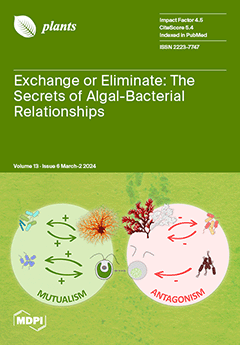Basella alba is a frequently consumed leafy vegetable. However, research on its nutritional components is limited. This study aimed to explore the variation in the nutritional components and antioxidant capacity of different cultivars and organs of
Basella alba. Here, we primarily chose classical spectrophotometry and high-performance liquid chromatography (HPLC) to characterize the variation in nutritional components and antioxidant capacity among different organs (inflorescences, green fruits, black fruits, leaves, and stems) of eight typical cultivars of
Basella alba. The determination indices (and methods) included the total soluble sugar (anthrone colorimetry), total soluble protein (the Bradford method), total chlorophyll (the ethanol-extracting method), total carotenoids (the ethanol-extracting method), total ascorbic acid (the HPLC method), total proanthocyanidins (the p-dimethylaminocinnamaldehyde method), total flavonoids (AlCl
3 colorimetry), total phenolics (the Folin method), and antioxidant capacity (the FRAP and ABTS methods). The results indicated that M5 and M6 exhibited advantages in their nutrient contents and antioxidant capacities. Additionally, the inflorescences demonstrated the highest total ascorbic acid and total phenolic contents, while the green and black fruits exhibited relatively high levels of total proanthocyanidins and antioxidant capacity. In a comparison between the green and black fruits, the green fruits showed higher levels of total chlorophyll (0.77–1.85 mg g
−1 DW), total proanthocyanidins (0.62–2.34 mg g
−1 DW), total phenolics (15.28–27.35 mg g
−1 DW), and ABTS (43.39–59.16%), while the black fruits exhibited higher levels of total soluble protein (65.45–89.48 mg g
−1 DW) and total soluble sugar (56.40–207.62 mg g
−1 DW) in most cultivars. Chlorophyll, carotenoids, and flavonoids were predominantly found in the leaves of most cultivars, whereas the total soluble sugar contents were highest in the stems of most cultivars. Overall, our findings underscore the significant influence of the cultivars on the nutritional composition of
Basella alba. Moreover, we observed notable variations in the nutrient contents among the different organs of the eight cultivars, and proanthocyanidins may contribute significantly to the antioxidant activity of the fruits. On the whole, this study provides a theoretical basis for the genetic breeding of
Basella alba and dietary nutrition and serves as a reference for the comprehensive utilization of this vegetable.
Full article






